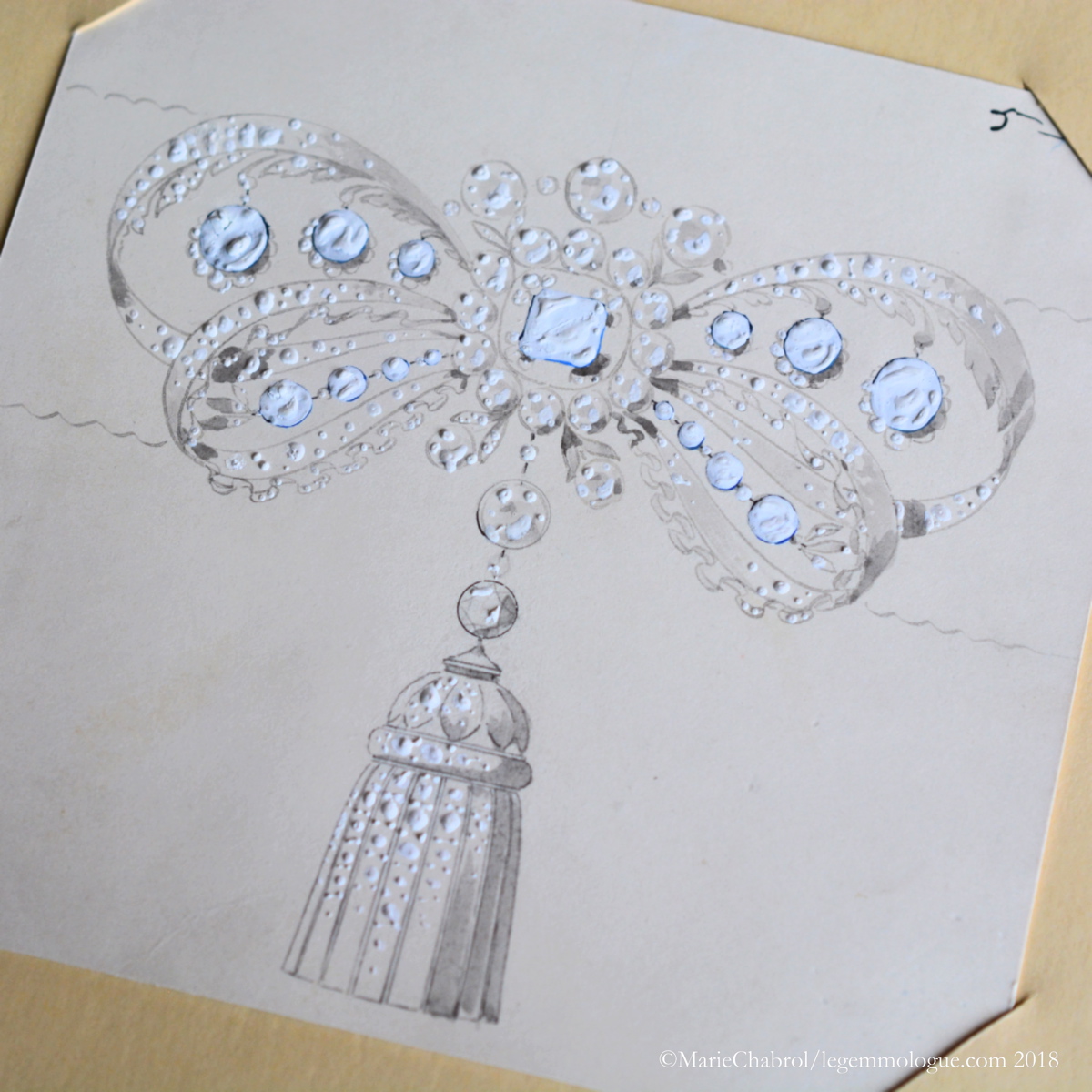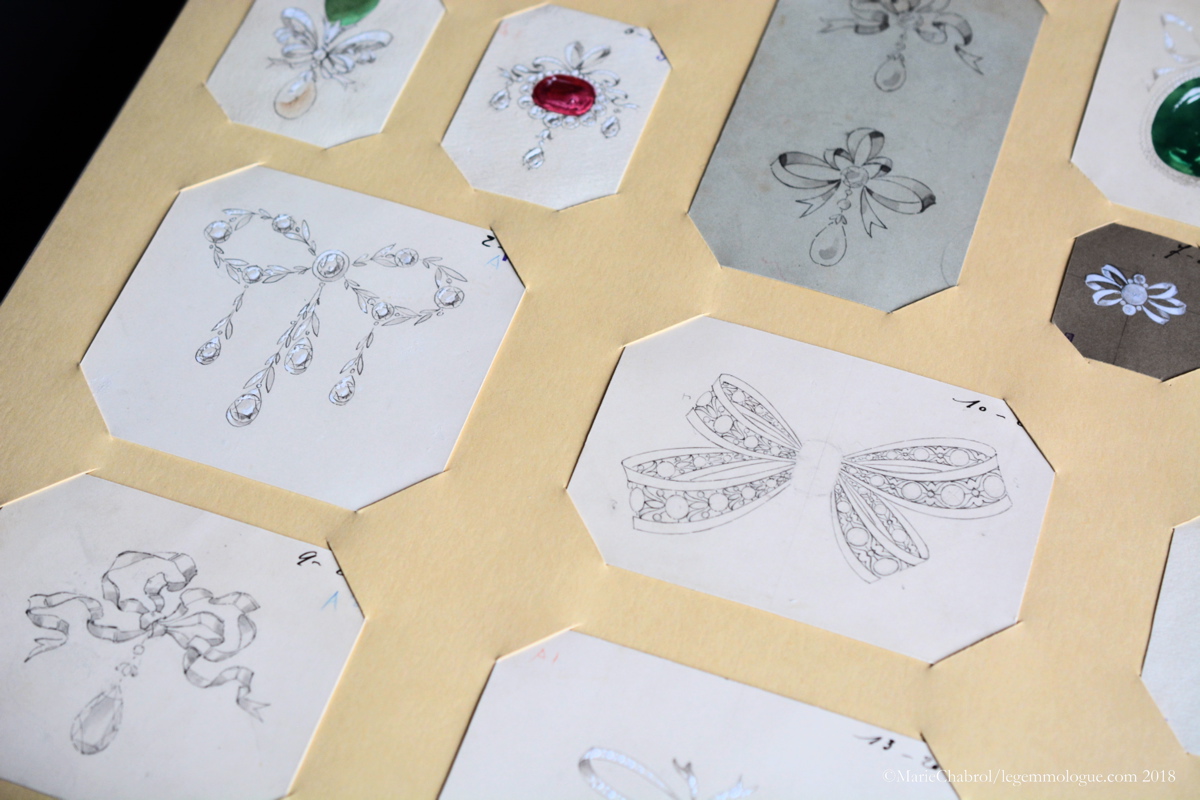On Place Vendôme, in addition to the world-famous column and the Ritz, the most famous French and international jewellery houses offer their most beautiful diamonds, their most beautiful emeralds and their dazzling jewellery to the dazzled eyes of walkers and enthusiasts. But this place conceals some well-kept secrets. Amongst the places unknown to the general public, there is one that is more surprising than the others: the Blue Office. It is in this boudoir, admirably restored, that I take you to discover a small part of one of the most beautiful treasures of the place: the archives of the Chaumet house.

A little history
The Chaumet house owes its name to a jeweller, Joseph Chaumet, who gave his name to the eponymous house after his marriage to Marie Morel, the daughter of the previous custodian of this address known for having supplied some of the most beautiful pieces to the French and European crowned heads. But it is a much older story that goes back to 1780 with the installation of Marie-Etienne Nitot. It was he who laid the foundations of this house. His son succeeded him in 1809. Then it was a story of transmission from workshop manager to workshop manager. There was the Fossin period, then Morel and then Chaumet.

Some sketches in the Fossin Album, around 1810. Photo: ©MarieChabrol
François-Régnault Nitot first set up the house at 15 Place Vendôme, where he acquired the town house in 1812. His flat and shop were then located there. Almost a century later, Joseph Chaumet moved the house to 12 Place Vendôme. We are in 1907, the address is now definitive. Like the rest of the square, this private mansion dates from the end of the 17th century. On the first floor is the Chaumet museum and its famous “diadem room”. This flat belonged to Claude Baudard de Vaudrier, lord of Saint-James, treasurer general of the navy for King Louis XVI. In 1777, he commissioned the architect François-Joseph Bélanger to create the Grand Salon. Now restored and classified as a Historic Monument, this is one of the most beautiful rooms in the square. The Blue Office was to be a room. For many years, it was the home of Béatrice de Plinval: she joined the company in 1969 as a designer, curator and creator of the company’s internal museum. Her successor was recently appointed. Guillaume Robic – who has worked for the Ministry of Culture, the CMN and the Monnaie de Paris– took up his post at the house on 1 January 2018.

Project for a platinum and diamond corsage front, circa 1910. Photo: ©MarieChabrol
The House Archives
Discovering the House’s archives means first of all immersing oneself in an absolutely astonishing and particularly complete collection. Very early on, the House’s jewellers kept documents to keep track of orders. Albums were made up of drawings, sketches and gouaches. These are numbered. Some albums are arranged around a theme, such as knots, while others date from a particular period. Even today, the house archivists do not know who made up these albums. There are no documents or “mission orders” of any kind. It seems that the collection was created completely empirically. The oldest drawings date from 1810. We are in the middle of the F.-R. Nitot period, whose workshop manager was Jean-Baptiste Fossin. These are not as elaborate gouaches as those we have seen in recent exhibitions devoted to this medium. This album is about sketches often made with graphite pencil. There are only a few colours, but the volume work is quite remarkable.

Project for a brooch in yellow gold and diamonds, circa 1970. Photo: ©MarieChabrol
To understand the richness and complexity of the collection, a few figures are necessary. The Chaumet archives are composed as follows
- 80,000 drawings, mainly in the famous albums
- 66,000 negatives of which 33,000 are actually glass plates.
- 300,000 photos on paper representing the pieces before delivery. However, this large number includes duplicates. In fact, some items may have been the subject of 3, 5 or even 10 identical photo prints.
- Then there are accounting documents: cash books, deposit books and even about 500 plaster casts, mainly made in the 19th century.
Finally, and this is one of the treasures of this collection, the house keeps some 500 maillechort models (often enhanced with gouache) which represent some of the house’s creations. These are mainly tiaras and bodice fronts.

Projects of bows. About 1920. Photo: ©MarieChabrol
Among the important elements, it is important to bear in mind that this collection is fairly homogeneous. This is not always the case with archives. Wars and removals can cause problems for conservation. Here, there are probably no “white zones”. Archivists are able to find the elements that researchers may need by consulting the various components of the collection: drawings, photo plates, paper prints or accounting documents, etc.

Detail of a sketch in the Fossin album, tiara project, ca. 1810. Photo: ©MarieChabrol
Research and the desire of the Chaumet company to preserve and exploit its archives has also made it possible to understand their constitution. We know, for example, that from 1870 onwards the company had in-house photographers. The photo studio was located on the Place because of the light. Before moving several times. But the study of certain photos reveals the reflection of the column…

Project of a front of bodice certainly in platinum, diamonds and perhaps aquamarines. Photo: ©MarieChabrol
Digitisation, a guarantee of preservation
From 1990 onwards, the company began to programme annual restoration and conservation campaigns for its archives. The old albums are entrusted to graphic arts restorers(INP) in order to stabilise them and to condition them differently when they are too damaged. Neutral paper and protective boxes are thus integrated in order to preserve this collection in the long term. Work has also been undertaken to create optimal hygrometric conditions for the preservation and consultation of the items. Chaumet’s heritage unit is gradually expanding. First one, then two people, and now five people work full time.

Project for a brooch in white and yellow gold, diamonds and possibly cat’s eye chrysoberyl. About 1970-1980. Photo: ©MarieChabrol
Photos are among the most complicated documents to preserve. The paper dries and cracks, the prints fade and do not stand the light of day. For example, the gouache prints from the Piscine exhibition will have to be kept in the dark for 18 months after a two-month exhibition. This is the time needed to “rest” them and make them last.

This 1907 sketch was the inspiration for the re-edition of the brooch presented in the July 2017 haute joaillerie collection. It is worth noting that it still exists and will be on display in Tokyo from June 2018 as part of a major exhibition dedicated to the house. Photo: ©MarieChabrol
Since the 2000s, digitisation has helped the work of archivists. Thus, the invoice books between 1838 and 1958 are now accessible in digital format. This saves time for research. Since last year, the photographic collection has been progressively digitised at the rate of recurrent campaigns. Because it takes time, a photo sometimes requires up to 15 minutes of work to obtain a satisfactory result.

Project for a diamond brooch on yellow gold, around 1970. Photo: ©MarieChabrol
A feast for the eyes
This visit and discovery of the archives was particularly inspiring. The Fossin album is remarkable for its content. But the thematic album on knots is even more surprising. Over hundreds of pages, sketches and gouaches testify to the talent of the company’s designers. And the knot, the DNA of the house, has been the object of a more than precise treatment. In all eras, in all styles and with all possible materials, it is constantly reinvented. Enthusiastic! Finally, I was delighted to dive into an album from the 1970s where yellow gold is perfectly treated. The work of the thread and the stones for timeless renderings. A real beautiful journey made possible by the team of the house who knew how to answer my too many questions!
See you soon!







